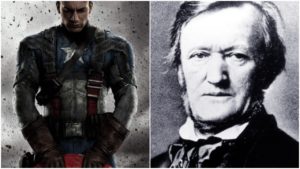
Opera Meets Film: Wagner’s Prophetic Appearance in ‘Captain America: The First Avenger’
By David Salazar“Opera Meets Film” is a feature dedicated to exploring the way that opera has been employed in cinema. We will select a section or a film in its entirety, highlighting the impact that utilizing the operatic form or sections from an opera can alter our perception of a film that we are viewing. This week’s installment features “Captain America: The First Avenger.”
Opera seems somewhat linked with the Marvel cinematic universe. To call some films, such as “Guardians of the Galaxy” or “Ant-Man” modern-day pop operas would not be a stretch given their use of music throughout the stories of these distinct films.
Yet sometimes the company is rather overt in using an operatic number as a means of exploring psychology and myth. This is what happens in “Captain America: The First Avenger.”
The film often picks obvious choices to explore its themes, which to be fair, are rather black and white in regards to its moral outlook of good and evil. Steve Rodgers is the ultimate good guy on a quest to prove his worth through bravery and a good heart. He gains superpowers because of this and becomes the ultimate hero, winning the heart of an incredible woman, and even, in Christ-like fashion, sacrificing himself for the good of humanity and then resurrecting years later.
On the other side of the spectrum are the Nazis, in this case, led by Johann Schmidt, a man obsessed with myth and harnessing the power of the Gods. He is the ultimate evil, his alter-ego being the Red Skull (his face is literally a red skull). It doesn’t get more evil than Schmidt in the Marvel cinematic universe. In fact, he is so evil that he even betrays Hitler and has plans to take over the world in the guise of Hydra, supplanting even the Nazis themselves.
Director Joe Johnston is so intent on presenting Schmidt as evil that he uses an old trope often associated with sophisticated villains – classical music or opera. At one point, as Schmidt is in conversation with his fellow colleague and underlying Dr. Zola, we clearly hear segments from Wagner’s “Der Ring des Nibelungen.” There are moments from Siegmund’s aria in Act one of “Die Walküre” as he calls for Wälse. There are segments from “Götterdämmerung,” specifically Siegfried funeral march, among others.
Historically, Hitler adored Wagner above all other composers and it was this association (as well as Wagner’s antisemitism) that damaged the composer’s reputation in the mid-1900s. So it would seem an obvious choice to have Wagner become Schmidt’s musical association in the film.
But it could have been any Wagnerian excerpt, perhaps a more obvious one like the Ride of Valkyries (Schmidt’s big project is actually called “Valkyrie,” which draws references to the operation aimed at murdering Hitler) Why then the passages that refer directly to the likes of Siegmund and Siegfried?
For Schmidt, using the Tesseract for power is quite similar to the Ring’s function throughout the “Ring Cycle.” It is a sacred object that gives incredible power to he who wields it. However, one of the major themes throughout the Ring as pertains to the Ring and other major weapons includes the nature of the character. Alberich, Fasolt, Fafner, and even Wotan become powerless when they interact with the Ring. Siegmund gets a sword from his father Wotan but is ultimately doomed and powerless due to his heritage. Siegfried is able to wield that very sword because of his free nature, but he ultimately winds up dead when he outwitted by those seeking control of the Ring. It is only Brünnhilde, who opts to burn the legacy left to her and start anew, that does not succumb to the evils of the Ring.
In “Captain America,” Schmidt uses the Tesseract’s power for evil, though it is ultimately used against him when Captain America frees the prisoners in his weapons factory. At the climax of the film, Schmidt grabs hold of the Tesseract and is ultimately destroyed by it. While Captain America himself never wields it or uses it, it is his strong sense of self that proves to be his saving grace. The film constantly talks about how the Captain’s strength and ability to survive his operation derived from his moral goodness, while Schmidt’s corruption turned him into a depiction of the devil himself. That the Captain never succumbs to the Tesseract the way Schmidt does is the film’s way of also expressing this sense of how strong positive human qualities are the ultimate means of success and victory. As a side note, Schmidt becomes a wanderer by “Avengers: Infinity War,” cursed with never retaining the power he believed he was destined for, but becoming a guide for stronger beings. This, no doubt, mirrors Wotan’s own fate in Wagner’s tetralogy.
Wagner’s use in the film then is ultimately a prophetic one, reminding us of the dangers of trying to harness the powers of the Gods without wholesome moral integrity.


